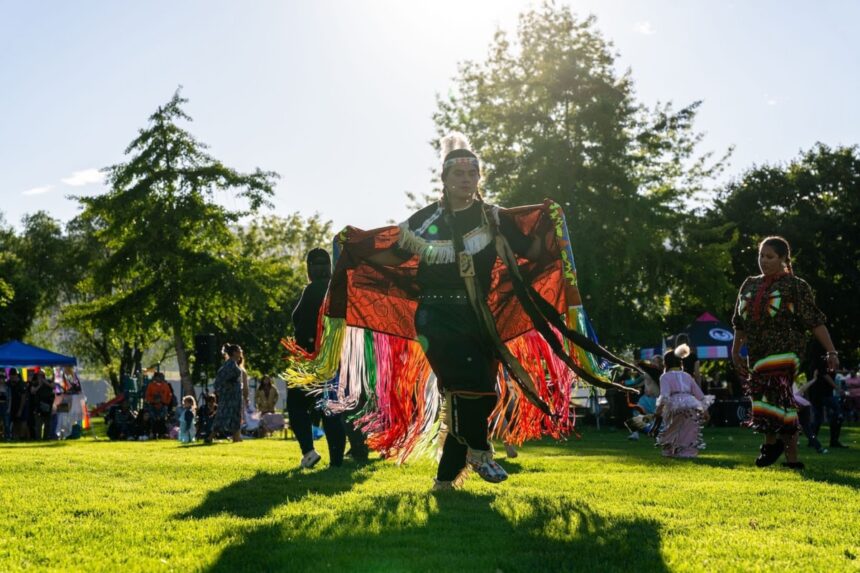The early spring sun breaks through cloud cover as I watch a group of volunteers carefully prepare the grounds at Parkinson Recreation Centre in Kelowna. Eagle feathers catch the light as dancers practice their steps, families set up chairs, and the steady rhythm of hand drums fills the air. This weekend marks the return of the Two-Spirit Powwow, a vibrant celebration that has quickly become an essential cultural touchstone for both Indigenous and 2SLGBTQ+ communities across the Okanagan Valley.
“We’re creating space where people can be their full selves,” explains Marnie Perrier, one of the event organizers and a member of the Syilx Nation. “For too long, Two-Spirit people were pushed to the margins of both Indigenous communities and mainstream society. This powwow represents healing that ripples outward.”
The term “Two-Spirit” was adopted at an Indigenous lesbian and gay conference in Winnipeg in 1990, but the concept—of individuals who embody both masculine and feminine spirits—has existed in many Indigenous cultures for centuries before colonization. Historical records from early European explorers and anthropologists document diverse gender expressions and special ceremonial roles for Two-Spirit people across numerous Nations.
“Before contact, Two-Spirit people were often medicine people, visionaries, peacekeepers,” says Elder Joseph Desjarlais, who travels from the Ktunaxa territory to participate in the Kelowna gathering. “We’re not reclaiming something new—we’re remembering who we’ve always been.”
What makes this particular powwow unique is its intentional weaving of traditional cultural practices with contemporary expressions of gender and sexual diversity. The Grand Entry—a powwow’s formal processional opening—features both traditional regalia and rainbow elements, while dance categories embrace all genders rather than strictly dividing them into male and female.
University of British Columbia Okanagan cultural studies professor Dr. Margo Tamez notes that these gatherings serve multiple purposes beyond celebration. “These spaces become sites of cultural reclamation and resistance against ongoing colonization. They’re also opportunities for education, both within Indigenous communities and for non-Indigenous allies.”
When I first arrived yesterday, I watched as young children trailed their fingers across the intricate beadwork on display at vendors’ tables. Parents explained the significance of different dance styles to curious onlookers. Throughout the day, spontaneous teaching moments emerged—a blending of cultural transmission and community building that feels organic rather than performative.
Kelowna resident Michael Toye brought his children to experience the powwow for the first time. “I want them to understand the rich diversity of our community,” he tells me as his daughter practices a basic dance step taught to her by a teenage participant. “Events like this help us all see beyond stereotypes.”
The powwow coincides with growing recognition of Two-Spirit identities throughout Canada. In 2016, Prime Minister Justin Trudeau became the first prime minister to march in a pride parade, carrying a flag that read “2SLGBTQ+,” acknowledging the specific place of Two-Spirit people. More recently, the Government of Canada has included Two-Spirit-specific funding in various reconciliation initiatives, though many community members express that such support comes after decades of grassroots organizing with limited resources.
Local Two-Spirit artist and dancer Jordan Williams speaks to this reality: “We’ve been doing this work for generations, mostly without institutional support. Now there’s more visibility, which is good, but we need to remember that our ancestors held these ceremonies when they were actually criminalized for it.”
Williams references the potlatch ban, which from 1885 to 1951 made traditional Indigenous ceremonies illegal under Canadian law. During this period, many cultural practices went underground, and some knowledge around Two-Spirit roles and teachings was lost or fragmented.
As afternoon stretches toward evening, the powwow transitions from competitive dancing to a community feast. Long tables fill with traditional foods alongside contemporary dishes. Elders are served first, in keeping with protocol. The atmosphere shifts from performance to communion as conversation flows between dance sets.
“Food brings everyone together,” says Cathy Manuel, who has been cooking for community gatherings for over thirty years. “This is how we show love, how we practice our values. Everyone eats together—no divisions.”
Several young Two-Spirit people share with me that this event represents a safe harbor in what can sometimes be challenging waters. “In some spaces, I’m too Indigenous. In others, I’m too queer,” explains Taylor Morrison, a 22-year-old student. “Here, I don’t have to choose between my identities. That freedom is powerful.”
Research published in the Canadian Journal of Public Health demonstrates that cultural connection serves as a protective factor against mental health challenges that disproportionately affect both Indigenous and 2SLGBTQ+ individuals. The Two-Spirit Powwow consciously addresses this reality by incorporating wellness resources alongside celebration, with mental health workers discreetly available throughout the event.
As drumming resumes for the evening session, I notice three generations of one family dancing together—grandmother, mother, and child moving in rhythm, their regalia a testament to survival and beauty. This image perhaps best captures what makes the Two-Spirit Powwow significant: it’s not just a cultural event but a living embodiment of continuity and change, tradition and innovation coexisting in the same circle.
The powwow continues through Sunday, with activities scheduled from 10 a.m. until 6 p.m. Admission is by donation, with proceeds supporting Two-Spirit youth programming throughout the year. Organizers emphasize that everyone is welcome to observe, learn, and participate as appropriate.
As I prepare to leave, a young dancer catches my eye. “Make sure you tell people this isn’t just history,” they say, adjusting a feather in their regalia. “This is our present and our future too.”






